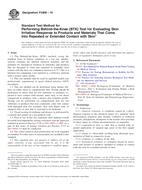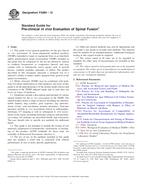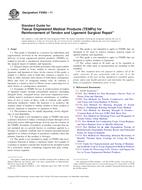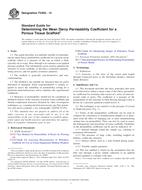Potřebujeme váš souhlas k využití jednotlivých dat, aby se vám mimo jiné mohly ukazovat informace týkající se vašich zájmů. Souhlas udělíte kliknutím na tlačítko „OK“.
ASTM D7427-14
Standard Test Method for Immunological Measurement of Four Principal Allergenic Proteins (Hev b 1, 3, 5 and 6.02) in Natural Rubber and Its Products Derived from Latex
Automaticky přeložený název:
Standardní zkušební metoda pro imunologické měření čtyř hlavních alergenních proteinů (HEV b 1, 3, 5 a 6,02), v přírodním kaučuku a jejích produktů získaných z latexu
NORMA vydána dne 1.9.2014
Informace o normě:
Označení normy: ASTM D7427-14
Poznámka: NEPLATNÁ
Datum vydání normy: 1.9.2014
Kód zboží: NS-38427
Počet stran: 16
Přibližná hmotnost: 48 g (0.11 liber)
Země: Americká technická norma
Kategorie: Technické normy ASTM
Kategorie - podobné normy:
Anotace textu normy ASTM D7427-14 :
Keywords:
allergens, Hevea brasiliensis, IEMA, immunoenzymetric assay, natural rubber latex, proteins, ICS Number Code 11.100.99 (Other standards related to laboratory medicine), 83.060 (Rubber)
Doplňující informace
| Significance and Use | ||||||||||||
|
5.1 IgE-mediated allergic reactions to protein allergens in natural rubber latex derived from the 5.2 Since no safe level of Hevea latex allergen exposure is known, avoidance is the primary mode of treating latex allergy. 5.3 As a result of investigations conducted by many scientists across the world, fourteen latex allergens have so far been identified and categorized by the Allergen Nomenclature Sub-Committee of the International Union of Immunological Societies (IUIS) as Hev b 1 to Hev b 13 (Table 1) (see Specification D1193). Reported sensitization rates for these allergenic Hev b proteins vary among the many reports as a result of differences in the study populations, IgE antibody assay methods and the quality of the Hev b allergens used as calibrators and quality control reagents in the analysis. Most studies, however, agree that Hev b 1 and Hev b 3 are important allergens for individuals (for example, children with spina bifida) who are exposed through mucosal contact as a result of multiple surgeries or latex catheter use for an extended period of time. Additionally, investigators performing sensitization studies also agree that Hev b 5 and Hev b 6.02 are important allergens that may elicit sensitization in genetically-predisposed individuals who are exposed to natural rubber latex 5.3.1 From the historical context, a number of assays have been developed to quantify the level of protein, antigen and allergen in natural rubber latex containing products (see Practices D4483 and D4678). 5.3.2 The modified Lowry assay for total protein, Test Method D5712, was the first assay of this type. It assesses the level of total protein as an indirect indicator of allergenicity of latex-containing products. This assay does not discriminate between the allergenic and non-allergenic proteins. 5.3.3 The second assay to be developed involved the use of human latex-specific IgE antibody in a 5.3.4 A third assay design is similar to the human IgE based competitive inhibition immunoassay, but it employs rabbit antiserum instead of human serum containing IgE anti-latex. The 5.3.5 The most recent assay, which is the subject of this standard, is the two-site immunoenzymetric assay (IEMA) which uses an insolubilized capture antibody to bind one of Hev b allergenic proteins from a latex product extract, and a second enzyme labeled detection antibody to detect bound allergens. Optical density responses are interpolated from reference curves constructed with known allergens. The performance characteristics of the reagents used in immunoenzymetric assays for Hev b 1, 3, 5 and 6.02 were investigated in the international collaborative study associated with the development of this standard and results are provided in Sections 15 through 17. |
||||||||||||
| 1. Scope | ||||||||||||
|
1.1 This test method covers an immunological method known as an immunoenzymetric assay to quantify the amount of 4 principal Hevea brasiliensis [Hev b] allergenic proteins [Hev b 1, Hev b 3, Hev b 5 and Hev b 6.02] in natural rubber and its products2 derived from latex using monoclonal antibodies specific for epitopes on these proteins. Since these assays quantify the levels of only 4 of the known 14 officially acknowledged allergens potentially present in natural rubber latex containing products, the sum of the four allergen levels shall be viewed as an indicator of the allergen burden and not as a measure of the total allergen content that can be released from the product. 1.2 For the purpose of this test method, the range of allergenic protein will be measured in terms of nanogram to microgram quantities per gram or unit surface area of a natural rubber containing product. 1.3 The test method is not designed to evaluate the potential of natural rubber containing materials to induce or elicit Type I (IgE-mediated) hypersensitivity reactions. 1.4 This test method should be used under controlled laboratory conditions to detect and quantify the level of 4 allergenic proteins found in natural rubber containing products. It should not be used to describe, appraise or assess the hazard or risk of these natural rubber containing materials or products under actual in use conditions. 1.5 The values stated in SI units are to be regarded as standard. No other units of measurement are included in this standard. 1.6 This standard does not purport to address all of the safety concerns, if any, associated with its use. It is the responsibility of the user of this standard to establish appropriate safety and health practices and determine the applicability of regulatory limitations prior to use. |
||||||||||||
| 2. Referenced Documents | ||||||||||||
|
Podobné normy:
Historická
1.2.2013
Historická
15.10.2010
Historická
1.12.2011
Historická
1.4.2012
Historická
1.3.2011
Historická
1.3.2014



 ASTM F2529-13
ASTM F2529-13 ASTM F2808-10
ASTM F2808-10 ASTM F2883-11
ASTM F2883-11 ASTM F2884-12
ASTM F2884-12 ASTM F2903-11
ASTM F2903-11 ASTM F2952-14
ASTM F2952-14
 Cookies
Cookies
